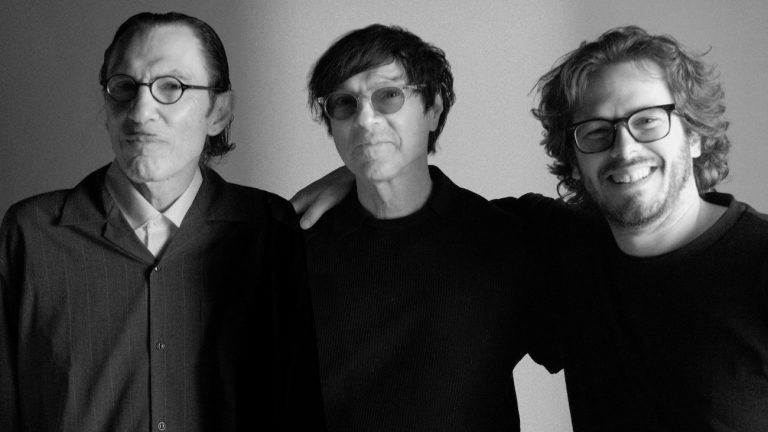The Sparks Brothers: A Music Doc Where Edgar Wright Goes Total Fanboy
Edgar Wright’s The Sparks Brothers is filled with gratuitous sax, senseless violins, and unadulterated adulation.

When Ron and Russell Mael, the two brothers who make up the cult band Sparks, were young, their father would take them to the movies every Saturday. He was a commercial and fine artist who didn’t bother timing these weekly excursions to any showing’s start time, and whatever film they were seeing was usually already playing by the time the family took their seats. Similarly, no matter where you start Edgar Wright’s documentary The Sparks Brothers, it’s like coming into a movie after it’s begun. This is brilliant, but you can’t exactly credit the director. It’s the subject.
According to the documentary, Sparks was the “best British group to ever come out of America.” You can look them up on Wikipedia and learn nothing. Everyone thinks they’re identical twins, but they weren’t even born in the same sunny California town. Sparks was so ahead of their time they were accused of ripping off artists from the future when they went retro. Ron Mael didn’t even know what a computer was when he wrote the song “Computer Girl” in 1966. They released an album called A Woofer in Tweeter’s Clothing 33 years before the formation of Twitter.
The Sparks Brothers is one of the wittiest documentaries to hit screens in years. It is completely straightforward and steadfastly chronological, yet it maintains a sense of fun, humor, and off-centeredness throughout. The more serious the subject matter, the more ironic the archival footage and corresponding song. Wright is best known for frantically paced comedies like Shaun of the Dead, Hot Fuzz, and Scott Pilgrim vs. the World. He not only makes sport of the genres he is parodying, he makes fun of parodies. This is his first music documentary, and he freely plays with the format itself.
The band is the same. Sparks is an art pop duo which doesn’t belong to any specific musical genre but itself. The unit released 25 albums, their most recent was last year’s A Steady Drip, Drip, Drip. In the documentary they promise there will hopefully be 200 to 300 more Sparks albums to come, with advances in medical technology.
For most of the band’s run, Sparks was more recognizable visually than they were musically. Russell Mael looked like a rock star. Ron resembled a Max Fleisher cartoon. He sported the same mustache as Charlie Chaplin. Or Adolf Hitler. Either way was fine with him, according to the documentary. He saw them both as cartoon characters. The documentary never mentions, however, that the Mael brothers are Jewish.
The Red Hot Chili Peppers’ fleet-fingered bassist Flea remembers in the doc when he stared reverently at a poster of the band, which hung in a friend’s bathroom. He says he had no idea what they sounded like, but the image burned into his mind. When John Lennon first saw them on TV; he rung up Ringo Starr and asked why Marc Bolan was playing with Hitler.
That wasn’t the brothers’ only Beatle encounter. After their dad died, their mom took them all the way to Las Vegas so they could catch a second Beatles concert. One of the classic rock star images Paul McCartney emulated in the music video for “Coming Up” was Ron’s clipped mustache. Right next to the Buddy Holly glasses, and the young Paul’s mop top. Mael admits in the documentary that he was almost impressed with his brother’s style.
The recounted stories are fun, and come across as great subjects for unwritten lyrics. The band learned a lesson in humility when they had to pay for groceries with food stamps the night after appearing on American Bandstand. Dick Clark appears very tickled by every performance of the band, but is positively giggly when Mael and Go-Go’s guitarist and songwriter Jane Wiedlin turn every one of his questions into sexually charged innuendo. Wiedlin reveals a short, but sweetly amusing love affair, which was the culmination of a teenage fantasy. Another fan talks about how she got past lax concert security to give Ron a full-bodied hug while he was working his keyboards. She says she regretted it the moment after because now she’d never be able to talk with him about the Beach Boys or poke fun at French art films. She would always be that little 14-year-old to him. It is one of the most poignant moments in the film.
Wright’s exploration will thrill Sparks fans, and explain to the uninitiated masses exactly what all the fuss is about. The band changed style from record to record, evolving and mutating, rocking and mocking. For their 1971 eponymous debut album for Todd Rundgren, they vamp vaudevillian vibes. “This Town Ain’t Big Enough for the Both of Us” from Kimono My House (1974) is pure pomp for operatic pop fans. When Island Records asks them to write a song people could dance to, they record the song “Music You Can Dance To.” This is the same label they’d tried to humiliate into paying for a music video by appearing on TV in front of a cardboard cutout TV in lieu of a prepared music film. The label drops them.
When both sides of the Atlantic go punk in 1979, Sparks work with disco maestro Giorgio Moroder. No 1 in Heaven was one of the first all-synthesizer pop-rock albums. Tony Visconti, frequent David Bowie collaborator, lovingly recounts the time he first heard them. He was in the velvet blackness of a photographic dark room and “nearly dropped my tongs, as they say in the photography world.” We hear how their collaboration aimed to be the band’s Sgt. Pepper, but didn’t set the charts on fire.
The documentary explores how cinema played a strong part in the Sparks’ output. They were made to be seen, and shot short films independent of the music. One of the biggest disappointments the film features is their dream of a collaboration with French New Wave filmmaker Jacques Tati in the early 1980s, which was dashed when the director died. One of the saddest stories to come out of the documentary is how Tim Burton cancelled a feature animated musical adaptation of the manga Mai, the Psychic Girl, which was more than a pet project for the band.
The film doesn’t give us much personal information on the Sparks brothers. We know Ron, now 75, and Russell, 72, are brothers, and have known each other a long time because they’re brothers. We know they’re not gay, in spite of the many gender role-reversals Ron threw himself into, when not stripping. But the only lover who gets mentioned is Wiedlin. We learn they like strong coffee, which they enjoy while poaching other bands’ musicians.
Ron and Russell Mael have been the only constant in Sparks for its five-decade run, but their many, many ex-bandmates don’t appear to hold grudges. Not even when they mention learning the Maels were moving to England only because they threw a yard sale. There is no gossip, no bitchiness, and no stories of over-the-top rockstar bad boy behavior or scandal.
What comes through strongest is the Mael brothers’ commitment to their art, and how serious they were about the silliest things. When Ron and Russel were in their 1967 band Halfnelson, their manager at the time told them to change the name to The Sparks Brothers, because of their love of the Marx Brothers. Wright restores the title properly with The Sparks Brothers. In an alternative universe, Sparks is the biggest band in the world, and not merely the Penn and Teller of art rock.
The Sparks Brothers opens in theaters June 18.

